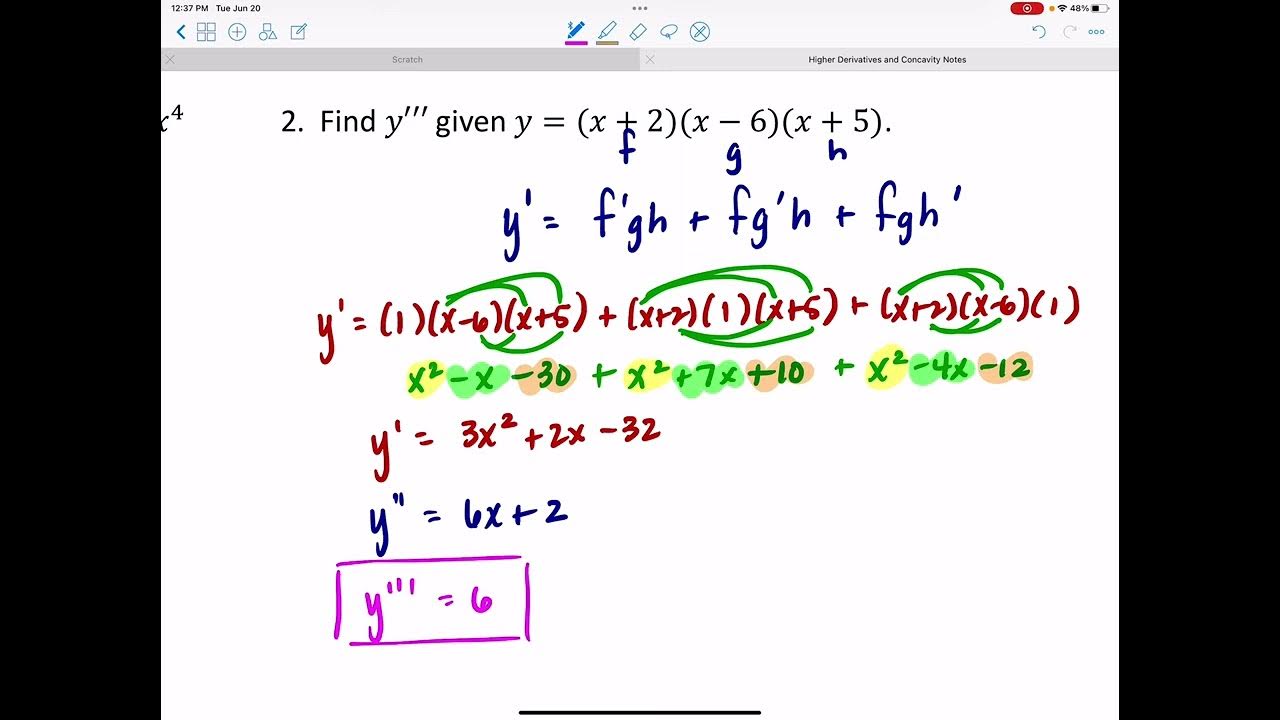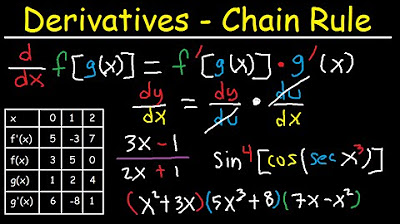Business Calculus - Math 1329 - Section 2.3 - Product and Quotient Rules; Higher-order Derivatives
TLDRThis video script delves into the intricacies of calculus, focusing on the product and quotient rules for derivatives, which are essential for finding the rates of change in various functions. The product rule is introduced as a method to find the derivative of a product of two functions, emphasizing that it is not simply the product of their individual derivatives. The script provides clear examples to illustrate how to apply the product rule and its shorthand notation. The quotient rule is also explained, highlighting the difference in sign compared to the product rule. Practical applications, such as finding horizontal tangent lines and calculating average profit functions, are discussed to demonstrate the utility of these rules. The video further explores higher-order derivatives, explaining the concepts of velocity, acceleration, and jerk in the context of physics. It concludes with examples of finding second, third, and fourth derivatives of given functions, and determining the velocity and acceleration of an object moving along a straight line, providing a comprehensive understanding of the topic.
Takeaways
- 📚 The product rule states that the derivative of a product of two functions is not simply the product of their derivatives, but a combination of them: (fg)' = f'g + fg'.
- 📝 The quotient rule is used to find the derivative of a quotient of two functions and is different from the product rule, with a subtraction in the middle: (f/g)' = (f'g - fg')/g^2.
- 🔢 In the context of derivatives, the first derivative represents the rate of change, such as velocity when dealing with distance over time.
- ⏱️ The second derivative indicates how the rate of change itself is changing, which in physics is known as acceleration.
- 🚀 Higher-order derivatives, such as the third and fourth, can describe more complex rates of change, like jerk (rate of change of acceleration).
- 📈 To find horizontal tangent lines on a curve, set the derivative of the function equal to zero and solve for the variable.
- 🛒 The average profit function is found by dividing the profit function by the number of items, and its rate of change is found using the quotient rule.
- 📊 When applying the quotient rule, it's important to note that the order of functions in the numerator and denominator matters.
- 🔑 The product and quotient rules are essential for finding derivatives of more complex functions that cannot be derived through basic differentiation.
- 🧮 Simplifying derivatives is crucial, as it often involves combining like terms and ensuring the expression is in its simplest form.
- ↔️ The direction of an object's movement can be determined by the sign of its velocity derivative, with positive indicating rightward movement and negative indicating leftward movement.
Q & A
What is the main focus of section 2.3 in the transcript?
-The main focus of section 2.3 is the product and quotient rules, as well as an introduction to higher-order derivatives.
Why can't you simply take the derivative of each function in a product and then multiply them together?
-You cannot do this because the derivative of a product of two functions does not equal the product of their derivatives. The product rule must be used to correctly find the derivative.
What is the product rule in shorthand notation?
-The product rule in shorthand notation is (d/dx)(F(x)G(x)) = F'(x)G(x) + G'(x)F(x), where F'(x) and G'(x) are the derivatives of F and G, respectively.
In the first example, what is the simplified derivative of the original product?
-The simplified derivative of the original product in the first example is 12x + 25.
How does the quotient rule differ from the product rule in terms of the sign between the terms?
-The quotient rule differs from the product rule in that the sign between the terms is a minus (-) instead of a plus (+).
What does the derivative of a function represent in terms of distance and time?
-The derivative of a function representing distance with respect to time gives the velocity, which is the rate of change of distance over time.
What is the second derivative of a function, and what is its physical interpretation in terms of motion?
-The second derivative of a function is the derivative of the first derivative. In terms of motion, it represents acceleration, which is the rate of change of velocity with respect to time.
What does it mean if the derivative of a function is equal to zero?
-If the derivative of a function is equal to zero, it indicates that the function has a horizontal tangent at that point, meaning there is neither an increasing nor decreasing slope at that specific point.
How is the average profit function defined in terms of the profit function?
-The average profit function (AP) is defined as the profit function (P) divided by the number of items (X), i.e., AP(X) = P(X) / X.
What is the physical interpretation of the third derivative of a function?
-The third derivative of a function, sometimes referred to as 'jerk,' represents the rate of change of acceleration with respect to time, which can describe the abruptness of changes in motion.
In the context of the eighth example, how can you determine the direction and whether the object is accelerating or decelerating after one second?
-To determine the direction, you evaluate the velocity function at one second. If the velocity is positive, the object is moving to the right; if negative, it's moving to the left. To determine if the object is accelerating or decelerating, you evaluate the acceleration function at one second. A positive acceleration means the object is speeding up, while a negative value means it is slowing down (decelerating).
Outlines
📚 Introduction to Product and Quotient Rules
This paragraph introduces the concept of the product and quotient rules in calculus. It explains that the product rule is necessary because the derivative of a product of two functions is not simply the product of their derivatives. The rule is stated as: (fg)' = f'g + fg'. The paragraph also covers an example where the product rule is applied to find the derivative of a function that is the product of two linear terms.
🔍 Applying the Product Rule to Polynomial Functions
The second paragraph delves deeper into applying the product rule with an example involving polynomial functions. It shows the process of breaking down the derivative of a product of a quadratic and a cubic polynomial into its components, then combining like terms to simplify the result. The explanation also touches on the concept of writing the product rule in shorthand notation.
🔢 Using the Product Rule to Find Horizontal Tangent Lines
This paragraph discusses how to use the product rule to find points where a curve has a horizontal tangent line. It demonstrates the process of taking the derivative of a product of two terms, setting the derivative equal to zero, and solving for the variable to find the points of horizontal tangency. The example involves a quadratic equation, which is solved using the quadratic formula.
📉 Deriving the Quotient Rule and Examples
The fourth paragraph introduces the quotient rule, which is used to find the derivative of a quotient of two functions. Unlike the product rule, the quotient rule involves subtraction and division by the square of the denominator function. An example is provided to illustrate the application of the quotient rule to find the derivative of a simple rational function.
💰 Calculating Average Profit and Its Rate of Change
The fifth paragraph explores the concept of average profit in the context of selling a certain number of calculators. It defines the average profit function and uses the quotient rule to find its derivative, which represents the rate of change of the average profit. The example calculates the rate of change at a specific point, highlighting the difference between the rate of change of profit and average profit.
🚀 Understanding Higher-Order Derivatives
This paragraph explains higher-order derivatives, which are the successive derivatives of a function. It covers the notation and physical interpretations of the second, third, and fourth derivatives, relating them to concepts such as velocity, acceleration, and jerk. The paragraph also provides examples of finding these higher-order derivatives for a given polynomial function.
🛣️ Velocity and Acceleration of an Object in Motion
The final paragraph applies the concepts of derivatives to physics by finding the velocity and acceleration functions of an object moving along a straight line. It uses the given position function to derive the velocity and acceleration and then evaluates them at a specific time to determine the direction of motion and whether the object is accelerating or decelerating at that moment.
Mindmap
Keywords
💡Product Rule
💡Quotient Rule
💡Derivative
💡Higher-Order Derivatives
💡Average Profit Function
💡Horizontal Tangent Lines
💡Velocity and Acceleration
💡Jerk
💡Chain Rule
💡Quadratic Formula
💡Simplified Derivative
Highlights
Introduction to product and quotient rules in section 2.3.
Explanation of why you can't simply multiply derivatives of functions in a product.
Statement of the product rule for differentiation.
Example 1: Applying the product rule to a simple polynomial function.
Example 2: Using the product rule for a more complex polynomial function.
Explanation of horizontal tangent lines and their relation to the derivative being zero.
Example 3: Finding where a curve has horizontal tangent lines using the product rule.
Introduction to the quotient rule for differentiation.
Example 4: Applying the quotient rule to a simple rational function.
Example 5: Using the quotient rule for a more complex rational function.
Discussion of average profit functions and their derivatives.
Example 6: Calculating the average profit function for selling calculators and its rate of change.
Explanation of higher-order derivatives and their relation to physical quantities like velocity and acceleration.
Example 7: Finding the second, third, and fourth derivatives of a polynomial function.
Example 8: Determining the velocity and acceleration of an object from its position function and evaluating its direction and acceleration after one second.
Conclusion and wrap-up of the main concepts discussed in the transcript.
Transcripts
Browse More Related Video

1.6 - The Product and Quotient Rules

AP Calculus AB and BC Unit 3 Review [Differentiation: Composite, Implicit, and Inverse Functions]

Higher Derivatives and Concavity

Derivatives of Composite Functions - Chain Rule, Product & Quotient Rule

AP Calculus AB and BC Unit 2 Review [Differentiation: Definition and Basic Derivative Rules]

Derivatives of Polynomial Functions: Power Rule, Product Rule, and Quotient Rule
5.0 / 5 (0 votes)
Thanks for rating: